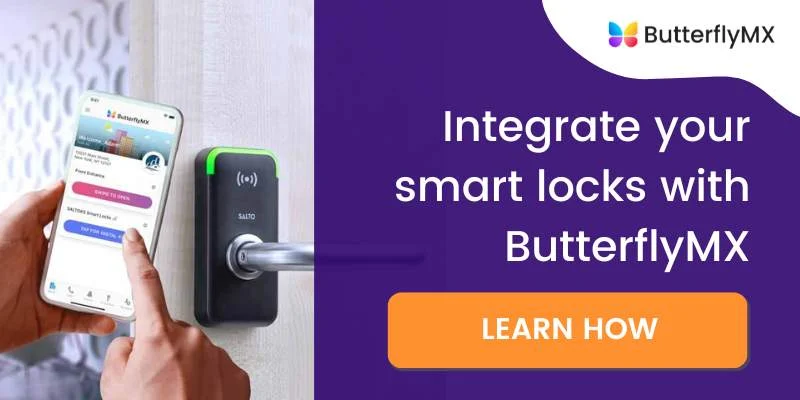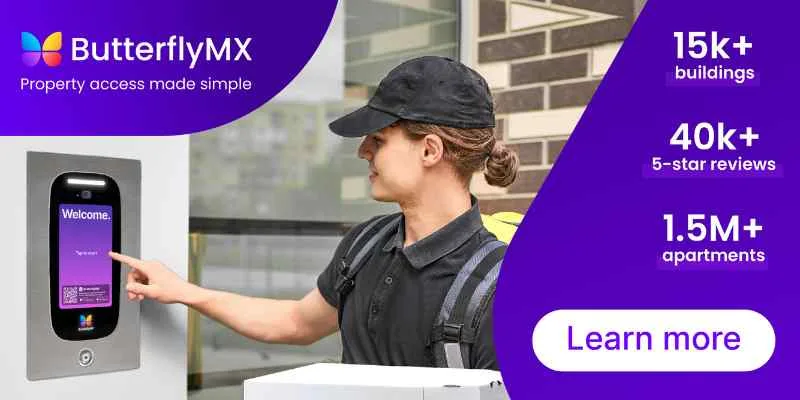Key takeaways
- The six steps to a smart lock installation include buying a smart lock, gathering the tools, replacing the old lock, setting up the power source, and connecting the smart lock to a smartphone.
- Common smart lock installation troubleshooting problems include connection, software, and flashing lights.
- You can install a smart lock yourself. However, some installations are more complicated than others and may require the help of a smart lock installation service.

Whether you’re installing for a client or you’re a property manager looking to perform a DIY installation, this smart lock installation guide will help you understand the process of installing smart door locks.
Below, we cover the step-by-step guide to installing a smart lock. Then, we detail common troubleshooting solutions. Last, we answer some of your top questions about installing a smart door lock at your property.
In this post, discover:
How to install a smart lock
Here are the most common steps to install a smart lock:
- Buy a smart door lock
- Gather the tools
- Replace the old lock with a smart lock
- Set up power source
- Connect smart lock to devices
1. Buy a smart door lock.
When replacing an old lock, your first task is to purchase a new one. Therefore, before shopping, you should understand what kind of smart lock to look for, depending on the property type and tenant needs.
Things to consider when buying a new smart lock include:
- Connection type. Does the property require a WiFi-connected smart lock or a Bluetooth-powered lock? Will you need a WiFi bridge? Before you purchase a lock, you should be able to answer these questions confidently.
- Power source. Many smart locks require batteries, while others are hardwired. Each property type will have its needs, and some tenants may prefer one power source over another. Each type of smart lock power source has advantages and disadvantages, so it’s highly recommended that you do your due diligence before buying and installing.
- Brand. There are many types of smart lock brands on the market — and some are more well-known than others. Yet, the consensus is that most smart lock brands are somewhat affordable compared to other types of smart home security devices. Your responsibility is to research which brand fits the property’s needs best.
- Usability. Are you looking for a smart lock alerting you when the door is unlocked? Or do you want a door lock that enables you to unlock/lock the deadbolt while you’re away? Depending on your needs, there are hundreds of smart lock types available.
2. Gather the tools
Here is a list of the proper tools for a smart lock installation:
- Deadbolt. Some smart lock brands, such as the Salto KS, suggest using a specific type of deadbolt lock for best results.
- Installation kit. Most smart locks come with an installation kit that includes specific screws, tools, and templates.
- Manual. Keeping the manual close by can mean the difference between a great installation and a faulty one. Moreover, you’re more likely to save time by referring to the manual than trying to rush through your installation without checking the steps.
3. Replace the old lock with a smart lock
The simplest step is to replace the old lock with the new one, which takes little time.
First, remove the screws supporting the lock on the door. Then, remove the knob and its components. However, you may come across a door knob without visible screws. In that case, you can follow the instructions below.
To remove a door lock without visible screws:
- First, look around the knob or handle for a small hole.
- When you find it, tilt the knob until you see a PIN appear.
- Then, insert the screwdriver until you feel the PIN click.
- Now, as you hold the screwdriver still, wiggle the handle until it comes off.
- Lastly, wedge the screwdriver between the metal cap and the door to leverage off the components.
Once you remove the old lock, replace it with the new smart lock using the specified instructions in the manual.

4. Set up power source
Now that the smart lock is installed according to its brand instructions, you can set up the power source.
If you’ve chosen to install a battery-powered smart door lock, you’ll insert the necessary batteries. On the other hand, if you’ve chosen a smart lock that runs on hardwired power, you’ll connect it to the building’s electrical system (which will require a more involved installation process).
5. Connect smart lock to devices
Now that the physical part of the smart door installation is complete, you can begin the setup process.
Here’s how to connect the smart lock to smartphone devices:
- Download the designated smartphone app and create an account.
- Select the smart device you want to connect.
- Connect the lock to your WiFi or Bluetooth.
- Create entry codes as prompted.
Discover how ButterflyMX integrates with smart locks:
Smart lock installation troubleshooting
Here are some of the top smart lock installation troubleshooting issues:
Connection issues
Connection issues when installing your smart lock system are common and shouldn’t cause panic. Most of the time, a connection issue is due to WiFi connectivity malfunctions.
The simplest way to fix this issue is to try restarting the WiFi router and try again. Secondly, you can try turning your device off and then on again. This should reset the system and make it easier to connect.
Software issues
Sometimes, if a smart lock has been sitting in a warehouse or shelf for a while, the software might require an update in order to work properly. In that case, running a software update is an easy fix and shouldn’t take longer than twenty minutes.
Flashing light
The cause of a flashing light on a newly–installed smart lock can vary. However, the most common reason is a faulty battery or low-power alert.
To fix this issue, change the batteries (or buy a type of battery with better longevity) and turn it on again. Or, check the hardwiring as the connection to the power source might not be secure.
Smart lock installation FAQs
Here are the answers to some of your common smart lock installation questions:
- How much does it cost to get a smart lock installed?
- Can I install a smart lock myself?
- Do I need a locksmith to install a smart lock?
How much does it cost to get a smart lock installed?
The average cost of a WiFi-enabled smart lock installation is anywhere between $300 and $500. However, the final price will depend on your location, the installer, and any subsequent additional charges.
Can I install a smart lock myself?
Yes, you can install a smart lock yourself.
However, it’s worth noting that some smart lock installations are more complex than others. Investing in a smart lock installation service can make the process easier if you plan to integrate your smart lock with other systems.
Do I need a locksmith to install a smart lock?
In most cases, you don’t need a locksmith to install a smart lock. But, a locksmith or installer will have industry knowledge that can help you make better decisions regarding the best access control and security options for your property.







